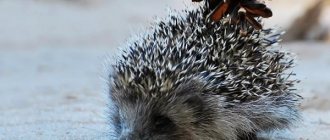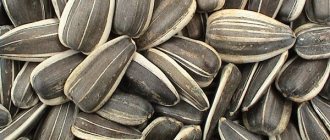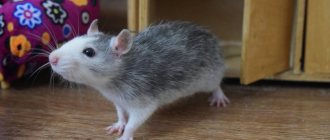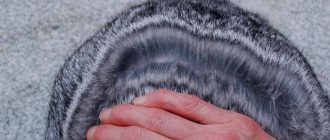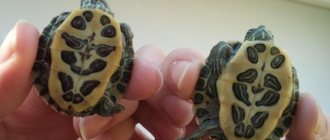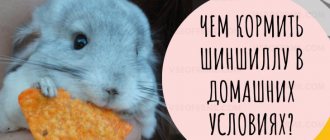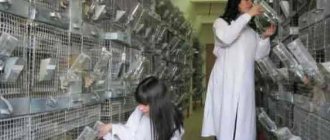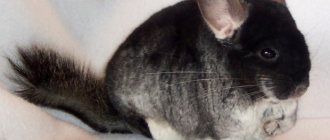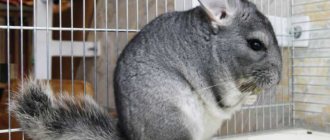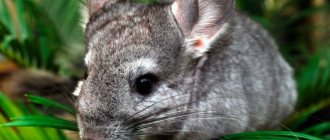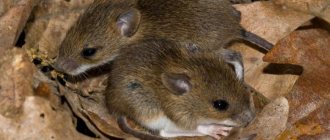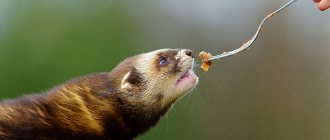The exotic rodent chinchilla is a popular pet with a pretty appearance and excellent health. With proper nutrition and care, a chinchilla can live up to 20 years. It is very important to choose the right diet for your pet. Poor-quality feeding disrupts the functioning of the reproductive and digestive systems and can cause premature death of the rodent.
In the article we will look at feeding chinchillas at home, what can and cannot be given to the animal, the features of the diet and which food is better to choose.
Rules for feeding pet chinchillas
The chinchilla is a herbivorous rodent that eats food in small quantities, but quite often.
Basic feeding rules:
- There should always be a supply of healthy food in your pet's feeder.
- New foods are introduced into the diet with caution.
- Balanced and varied menu.
- Chinchillas are very active, so they need high-calorie food, which also keeps the rodent's beautiful fur healthy.
Nutrition and daily routine
Chinchillas are nocturnal. Activity appears closer to 18-20 pm. The owner must ensure that there is enough food in the pet's feeder to eat at night.
It is better to feed the rodent at the same time. He will quickly get used to the regime, which will have a positive effect on the digestion process.
Chinchillas have sharp teeth that grow throughout their lives. In order for the pet to have the opportunity to grind down its teeth if necessary, you need to put tree branches in the cage, with the exception of coniferous species with a high resin content. Preferred are apple, linden, birch and hazel.
In addition to wooden twigs, special toys, mineral and chalk stones are also used.
Composition and balance of the diet
The diet for a pet rodent is selected individually, taking into account the pet’s age, health status, taste preferences and physiological characteristics of the body.
The main composition of the diet for pet chinchillas:
- Rough feed - hay, branches of trees and shrubs.
- Grain mixtures for chinchillas.
- Treats – berries and nuts, dried fruits, vegetables.
The daily food intake for an adult pet is 55-65 g. A balanced diet involves feeding in the following ratio: 25 g of roughage, 25 g of grain mixture, up to 5 g of vegetables and the same amount of additional treats.
How to feed
The first feeding takes place no earlier than 6 pm. The owner can pour grain feed into the feeder. It is not necessary to calculate the portion. Chinchillas are not prone to gluttony and obesity, so they will eat exactly as much as their body needs.
There should always be fresh and clean hay in the cage. The bundle can be placed in a certain corner or in a special hay feeder. Make sure your chinchilla is never left without this tasty and healthy food.
Drinking regime
Clean drinking water should always be freely available to the rodent. It is better to use distilled or filtered water. You should not give chinchillas regular tap water. You can also give chinchillas a decoction of chamomile, rose hips, and currants without adding sugar.
Cell preparation
Before purchasing an animal, a cage for the chinchilla should already be prepared. This will be her home, a home and a refuge in which she will sleep, eat, bathe and give birth.
Large cage for chinchilla
Therefore, there are certain requirements for the cage:
- The cage should be located in a cool place. Chinchillas cannot tolerate heat; the optimal air temperature for them is 20 degrees. If it is 25 degrees in the cage, then the animal will overheat its body; at 30 degrees it will die;
- The size of the cage should be approximately 50x50x100 cm, that is, it must be of a tower type, greater in height than width and depth. This is a very active animal; the cage must have floors with stairs so that it can run a lot;
- If possible, try to hang the feeder and water bowl, otherwise the chinchilla may turn them into a toilet;
- There should always be a piece of chalk or a special stone in the cage for grinding down teeth. You can buy it at any pet store;
- The bottom of the cage should be lined with sawdust. The animal goes to the toilet anywhere, they cannot be tamed to the toilet, so the sawdust will have to be changed often. Although some people succeed in toilet training;
- They have fur that is very sensitive to dirt; it even reacts to sweaty human palms. Therefore, the animal often bathes, but not in water, but in special zeolite sand. They do not require water for these purposes.
Taking sand baths
Special sand for bathing
By the way, when taking sand baths, chinchillas are so violent that dust will fly in all directions. It is not advisable to carry out these procedures in a cage so as not to clean up later. The ideal solution is a three-liter jar. We poured sand in a layer of 5 cm, put the animal in there, and left it in a cool place for an hour. Although the duration can be reduced to half an hour, but not less.
Chinchilla bathes in the sand
A chinchilla should be bathed at home a couple of times a week. If your home is hot (i.e. about 25 degrees) and there is high humidity, then you should bathe every other day. The thing is that the animal does not have sweat glands, and without these procedures you can forget about beautiful, healthy fur.
In the wild, they bathe in volcanic dust, but never in sand. And at home, you also need to follow this rule - only special sand. If you add regular river water, you will get at least two problems:
- Skin diseases, fungus;
- Ugly, chewed, tousled fur, as if the chinchilla had been in a centrifuge.
A visual technique for a sand bath
For preventive purposes, for example, against lichen, the antifungal drug fungistop is sometimes added to the sand in the proportion of 1 large spoon of the drug per 1 kg of sand.
Animal behavior at home
Chinchillas require much less care than, for example, . The main thing is to keep it cool. If the animal is released from the cage, it will immediately begin to explore every crevice in the room, because... their ancestors lived in endless labyrinths of rock slides that appeared after volcanic activity and earthquakes.
Please note that they try everything to their teeth, this is the instinct of a rodent, so you should not leave them outside the cage unattended. Cases of biting live wires with inevitable death are very common.
Chinchillas don’t really need to communicate with people, they are somewhat cowardly animals, and prefer to play with themselves, simply running around the floors of the cage and gnawing everything in sight (that’s why a spacious cage is needed). Also keep in mind that this is a very shy animal and can die from fright.
Also, you should not pick up a chinchilla by the back, because... she may shed her fur. Here, for example, is a chinchilla, photo below, which did just that:
Chinchilla shed a tuft of fur
This is normal, so they have a chance to escape from the predator's mouth. Even though we are not going to eat them, the instinct remains. But let us warn you again - they die from severe fright! And being grabbed by the scruff of the neck from behind is also frightening.
Domestic chinchillas are mostly nocturnal, so get used to the nightly rustling, squeaking, and stomping that can last half the night.
List of healthy foods for chinchillas
When creating a menu for a pet rodent, you need to take into account the body's daily need for proteins, carbohydrates and fats.
Percentage of useful components:
- Proteins – up to 20%. This component is responsible for cell regeneration and fur elasticity. Lactating and pregnant rodents need to be given protein food in increased quantities, as it is responsible for the process of formation of the young's organs and milk production.
- Carbohydrates – up to 30-35% of the daily feed. They normalize the functioning of the digestive system and promote the removal of toxins from the body.
- Fats – 4-5%. They promote proper development, improve the condition of fur, and are an important source of energy for rodents.
The chinchilla's body also needs:
- magnesium – stimulating the body’s defense reactions;
- potassium – normalizes water-salt balance;
- folic acid – improves intestinal function;
- iron – promotes proper transport of oxygen to tissues.
An exotic pet's diet should contain healthy and high-quality products.
What to feed chinchillas:
- fresh hay;
- tree branches - pear, apple, sea buckthorn, birch, willow, etc.;
- dried herbs - parsley, spinach, burdock, plantain, clover, lettuce, dandelion grass, etc.;
- tree leaves;
- grain mixtures - wheat, corn, buckwheat, oatmeal, pearl barley;
- legumes - peas, beans, beans;
- pieces of dried vegetables - carrots, zucchini, tomatoes, bell peppers;
- dried fruits - apples, pears, grapes, bananas, apricots, figs;
- dried berries - blueberries, wild strawberries, strawberries, rose hips;
- nuts - walnuts, hazelnuts, peanuts.
The diet of pregnant and lactating chinchillas must include dairy products: milk, kefir, natural yogurt, cottage cheese, yogurt.
Vitamins and their benefits for pets
Vitamin complexes are not only intended for young, sick, lactating, pregnant and weakened animals. The intake of vitamins in food will protect your pet from possible illnesses. These supplements are sold in pet stores and come in liquid, powder or solid form.
Tablets and powders are extremely difficult to feed to a fluffy dog. Therefore, it is better to choose fortified complementary foods in liquid form . So it can be easily mixed into water and the rodent’s diet will be significantly enriched.
Make sure that there are always salt and mineral stones in the chinchilla's cage. They will have a beneficial effect on the animal’s body and help it take care of its constantly growing teeth.
Dry yeast can replenish protein reserves. They will also help enrich the chinchilla’s body with B vitamins. It is important to add them to the food a little at a time.
Pros and cons of keeping chinchillas in an apartment.
What not to give to chinchillas
Chinchillas should not be fed food from their table, as well as various foods not intended for these animals. There is also a list of products prohibited for feeding exotic rodents.
What not to give to chinchillas:
- from grain crops - rye;
- juicy herbs, vegetables and fruits, because chinchillas may have indigestion;
- leaves of lily of the valley, buttercup, milkweed, field mustard, datura, marigold, fern, poisonous buttercup, larkspur and hemlock - these herbs are poisonous;
- branches - coniferous trees, chestnut, maple, cypress, white acacia, elderberry, plum, apricot, cherry;
- from fruits - citrus fruits, persimmons;
- vegetables – potatoes and fresh cabbage;
- pine nuts and almonds;
- apricot kernels;
- offal;
- meat, bones;
- any sweets (including dried fruits), honey;
- hard cheese;
- sausage and smoked meats;
- products of non-natural origin.
Types of feed
A chinchilla can be fed a variety of foods. Some of them are mandatory and form the bulk of the daily diet.
Roughage
Rough feed includes hay and tree branches. These animals' digestive system is designed in such a way that if there is no hay, they can die suddenly. You can purchase the finished product in the store. It is better to give preference to hay, which consists of forbs (timothy, dandelion, clover, vetch, etc.). Hay is also necessary for grinding down the back teeth - prepainters.
Some owners make hay themselves, but in this case you need to be extremely careful. Pathogenic microorganisms, dangerous fungi and mold can multiply in the harvested hay. This product should not be given to a pet rodent. This can cause severe poisoning, even death.
To destroy pathogenic microorganisms that may be present in the hay, it is necessary to use special products from veterinary pharmacies. After treatment with this composition, all hazardous elements are neutralized.
In addition to hay, the diet of a domestic chinchilla should always include branches of bushes and trees. With their help, the pet regularly sharpens its teeth (incisors).
Herbs and plants
Herbs and plants are useful supplements of plant origin that should be given to your pet in limited quantities. The daily norm is up to 5-10 g.
Ready mixes
In the store you can buy ready-made mixtures for feeding pet chinchillas. High-quality food contains all the necessary vitamins and mineral complexes necessary for the healthy growth and development of your pet.
The composition of ready-made mixtures includes different components: grains, cereals, seeds, bran, etc.
Cereals
Grain mixtures form an important part of the daily diet of pet chinchillas. This product contains all the necessary vitamins, minerals, proteins, fats and other beneficial microelements.
It is not advisable to feed your pet one type of grain. Priority is given to feeding a mixture of different grains.
Vegetables and fruits
Juicy foods include fresh vegetables and fruits. These products are a real storehouse of useful vitamins and minerals. They are served to your pet as a treat in small pieces. Fruits and vegetables can only be given to chinchillas in dried form.
After feeding a new product, the owner needs to monitor the condition of the rodent. If symptoms of intestinal upset are observed, it is better to exclude this product from the diet.
A chinchilla should not be fed spoiled, rotten, stale or unripe fruits and vegetables! Such feeding will lead to illness and death of the pet.
Vitamins and treats
The animal should receive the bulk of its vitamins from daily food. During cold weather, additional vitamin supplements should be introduced into the diet. You can buy them in the store.
You can diversify your rodent's menu with various delicacies - berries, nuts, fresh and dried fruits. It is better to alternate such products and be sure to dose them. Each complementary food is given in strictly limited portions. Overeating on treats can cause serious harm to your health.
Natural treats
The main treat for chinchillas is dried apples. They contain fiber, which promotes proper digestion. Remove toxic waste products and improve overall metabolism in the animal’s body. Like carrots, apples help strengthen fur and the cardiovascular system.
Dried carrots are perfect for constant pampering. It contains vitamins A, B, C, E, a large amount of iron, potassium, calcium. As you know, this is the main supplier of beneficial carotene to the body. Carrots are a natural teeth cleaner. Since it awakens the appetite, you don’t need to give it a lot at once - a pinch a day is enough. Sweet pepper in the same quantity is an excellent vitamin supplement that strengthens teeth, gums and immunity.
Raisins are given to strengthen the heart, as a cure for anemia and weakness. Chinchillas love it very much because raisins contain a lot of sugar. But you should not give more than 1 berry per week. Raspberries can be given fresh or dried, 2-3 berries per week (like hawthorn). It is rich in organic acids and salts of iron, potassium, and copper. Dried hawthorn is more of a medicine than a tasty treat. It helps to calm down, cope with stress, and is also indispensable for intestinal upset. The same amount of pumpkin seeds can be given to improve digestion, skin, and hair follicles.
Chokeberry is also rich in amino acids and rare vitamin P. Together with sweet pepper, they normalize the composition of vitamins and microelements in the chinchilla’s body. In addition to the listed delicacies, you can give nettles, oats, almonds, linden flowers, and fresh (not fried!) sunflower seeds. Chinchillas also love to sip green tea from time to time. It is rich in vitamins B1, B2, K, C, BB, and optimizes the nervous system. Green tea is a powerful antioxidant; it is better not to give more than a teaspoon per week.
Peculiarities of chinchilla nutrition at different periods of life
When compiling a diet for a domestic chinchilla, it is necessary to take into account the physiological characteristics of the body, characteristic of different periods of the rodent’s life.
Pregnancy
A pregnant chinchilla requires special care and proper nutrition. The diet should be varied and balanced. During this period, the female’s appetite improves, so the daily food intake needs to be increased. The feeder should always have a supply of fresh and healthy food.
Additionally, you can include vitamin supplements intended for pregnant rodents in the main menu. Barley and sprouted oats are very useful for expectant mothers. They contain a large amount of vitamin E, which is necessary for the proper development of the fetus. If it is deficient, the pregnancy may be terminated.
2-3 weeks before giving birth, the chinchilla should be fed with pieces of dried apples. After the rodents are born, the herbs calendula, alfalfa and strawberries are introduced into the diet of the nursing mother. These herbs improve lactation.
Growth period
For small rodents, the basis of the diet is nutritious concentrated food low in fat and sugar. You can feed your growing pet ready-made granulated food from leading manufacturers. They contain a balanced amount of nutrients - vitamins, minerals, carbohydrates, proteins, fats and other components, selected taking into account the physiological characteristics of the young body.
Disease
For various reasons, a chinchilla can develop various diseases that worsen the pet’s general condition and its appetite. A veterinarian prescribes proper nutrition for a sick rodent, taking into account the disease itself and the characteristics of the body.
During illness, the chinchilla must be constantly fed with clean drinking water. If the rodent refuses to eat on its own, the owner can feed it paste-like food using a pipette. Additionally, vitamin and mineral complexes can be introduced into the diet. Detailed nutritional instructions for a sick rodent are issued by the attending veterinarian.
In our store you can buy balanced and healthy food for pet chinchillas. The assortment includes high quality products from the world's best manufacturers. Also available are cages, feeders, drinking bowls and other items for a comfortable and healthy life for an exotic pet.
Temperature
How to help a chinchilla cope with the heat?
Only temporary measures are described here - they will help when you urgently need to cool your pet:
In winter, your pet is not in danger of overheating, even if the apartment is heavily heated. We move the cage away from the radiators and open the windows for winter ventilation.
In summer you have to regulate the temperature using an air conditioner; a portable one will do. But a fan won’t help: it only moves the air, not cools it. Simply opening the window as much as possible is also a bad idea: drafts are harmful to chinchillas.
In general, if you are not ready to spend money on air conditioning, then you don’t need to get a chinchilla.
